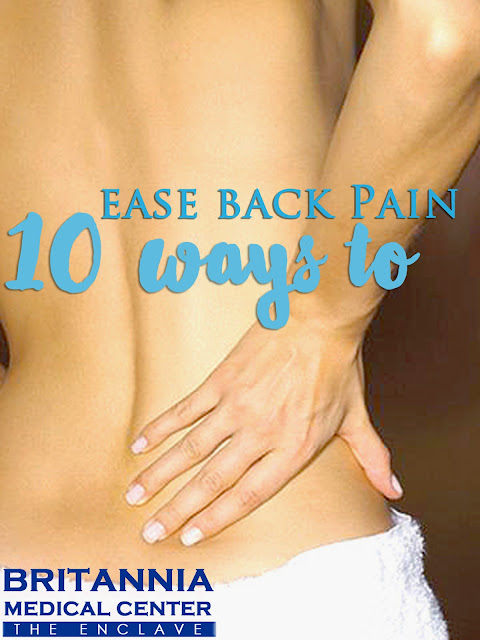Nearly everyone suffers from some type of back pain at some point in
their lives. But no matter when it appears or what may have caused it, back pain
can be a real, well…pain, to deal with. The good news? There are simple things you
can do to prevent back pain and to keep your back in good condition. And if
you're suffering from a back pain problem, try the following tips and you could
be on your way towards feeling better.
A Good Night's Sleep
Sleep disturbances are common among back pain sufferers, but
peaceful slumber helps to repair strained muscles and soothe inflamed joints.
For a better night's sleep, start with a good bed and experiment with
different sleeping positions. Try sleeping on your side — and on a firm surface
— to prevent any curvature of the spine that could lead to or worsen back pain.
Additionally, some people find that sleeping with a pillow between their knees
helps them sleep more comfortably.
Gentle Exercise
When back pain begins, it's not always the best idea to simply
rest and wait for the pain to subside. Resting can cause certain types of back
pain to worsen and decrease muscle strength. Instead of lying down, start with
gentle stretches and try experimenting to
see in what ways you can move without pain. Try going out for a slow, easy
walk, and pick up the pace if it feels good. Regular exercise is also a smart
idea — strengthening and stretching the muscles can reduce or eliminate many
types of back pain. However, it's best to discuss your current routine and any
changes to it with your doctor to avoid aggravating your condition.
Healthy Weight
"Having excess weight pulling on your back 24 hours a day
except when you're laying down is just bad news for the back," says Lauri
Grossman, DO, a licensed chiropractor and the founder of the Department of
Homeopathic Medicine at New York University. "People who wrestle with back
pain for a lifetime, if they lose a few pounds, often they find that the pain
that they've taken a million medicines for and a million vitamins for — often
that just goes away." If you're having trouble shedding extra pounds, consider consulting with a nutritionist or personal trainer.
Bodywork
"Whenever I work with any patient, I always want to make sure
they're getting some form of bodywork," Dr. Grossman says. "I think
that's very important. Chiropractic, osteopathy, physical therapy, some form of body therapy." Other specialized bodywork
classes include the Alexander technique, which improves overall health by
encouraging proper posture, non-injury flaring movements, and alignment of the
head, neck, and trunk; and the Feldenkrais method, which gently increases
flexibility, coordination, and awareness of body movement.
Yoga
According to Susi Hately Aldous, owner of Functional Synergy, Inc.
in Alberta, Canada, and author of several international best-selling yoga
books, yoga can be very therapeutic for
back pain sufferers. "Yoga helps improve back pain in three ways:
unwinding myofascial tightness and imbalances, increasing body awareness, and
improving breathing involving fluid movement of the diaphragm," she
explains. "Without this fluid movement, excessive tension builds.
Effective breathing also induces a "relaxation response" in the
parasympathetic nervous system and that response helps to further relieve
muscle tension and back pain."
Painkillers
For short-term pain relief,
over-the-counter NSAIDs (non-steroidal anti-inflammatory drugs) are sometimes
suggested. The most common NSAIDs include aspirin, ibuprofen, and
acetaminophen. Potential side effects of NSAIDs include stomach and liver
problems. Talk to your doctor if you don't find relief after taking the recommended
dosage.
Natural Supplements
Grossman advises her patients with back pain to take glucosamine
(500 mgs, three times a day), flaxseed oil (two teaspoons per day), calcium and
magnesium (see the indications on the bottle), zinc (50 mgs a day), and vitamin
C (2,000 mgs a day). "Those are the best supplements for back pain," she
says, "and in terms of topical treatments, arnica gels and creams can be
very helpful and won't interfere with anything you're taking. And they're
inexpensive, too."
Heat and Cold
"I always tell my patients to play around [with hot and cold therapy] and see what feels better for them," says Grossman.
Generally speaking, cold therapy (applied via an ice pack) works better for
inflammation and helps to reduce swelling, while heat (via a hot water bottle
or heating pad) is ideal for reducing cramping and muscle spasms. "Often
moist heat is better; but be careful of dry heat, because it can actually
dehydrate the tissue and prevent healing," Grossman advises.
Aquatic Therapy and Whirlpools
Physical therapists often recommend aquatic therapy for patients
with back pain. This can include exercises done in warm, therapeutic
pools — the buoyancy of the water helps deter strain on the joints — to
encourage strengthening of muscles, gentle stretching, or floating to relax the
muscles and release tension. Whirlpool baths work on the same principle: The
heat encourages muscle relaxation and the movement of the water increases
circulation. With home whirlpool units, try aiming the jets directly at your
sore spots for a soothing underwater massage.
Electric Stimulation
Transcutaneous electrical nerve stimulator (TENS) machines are
small, battery-powered devices that transmit low-voltage electrical currents
through electrodes that are attached to your skin. Considered very safe, TENS machines, according to one theory, work by scrambling the message of pain
to the brain — literally blocking it. Another theory is that the electrical
impulses cause endorphins to be released that override the sensation of pain.
Many back pain patients have had success with TENS machines, though their
effectiveness has not been clearly proven in controlled studies. Ask your
doctor or physical therapist if this therapy might be right for you.

No comments:
Post a Comment